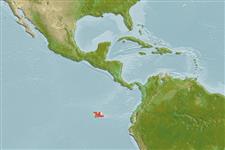>
Ovalentaria/misc (Various families in series Ovalentaria) >
Pomacentridae (Damselfishes) > Chrominae
Etymology: Azurina: Latin, azurinus = blue, pale blue; the name of Leuciscus caeruleus, blue Roach; 1600 (Ref. 45335).
Environment: milieu / climate zone / depth range / distribution range
экология
морской ассоциированный с рифами; немигрирующий; пределы глубины 5 - 30 m (Ref. 28023). Tropical; 1°N - 1°S
Eastern Central Pacific: Cocos and the Galapagos Islands. This species has not been seen since the 1982/83 El Niño event (Ref. 27438).
Size / Вес / Возраст
Maturity: Lm ? range ? - ? cm
Max length : 15.0 cm SL самец/пол неопределен; (Ref. 28023)
Краткое описание
определительные ключи | морфология | морфометрия
колючие лучи спинного плавника (общее число) : 13; членистые (мягкие) лучи спинного плавника (общее число) : 10 - 11; колючие лучи анального плавника: 2; членистые (мягкие) лучи анального плавника: 11 - 12. Color olive-gray with a light-blue tint, silver on the ventral side; snout dusky, a black spot at pectoral fin base; pale gray pelvic and anal fins, dusky dorsal fin. Body more slender compared to other Galápagos damselfish. Preorbital bone smooth without a notchlike projection; edge of preopercle irregular, weakly serrate. Lateral line complete and conspicuous (Ref. 28023).
Apparently this species prefers open water near drop-offs, although individuals are found in a variety of inshore habitats to depths of 30 meters. It is not a common species and resident aggregations have strong preferences for specific sites. Feeds mainly on plankton in the water column, usually in heterotypic aggregations with Chromis atrilobata. Oviparous, distinct pairing during breeding (Ref. 205). Eggs are demersal and adhere to the substrate (Ref. 205). Males guard and aerate the eggs (Ref. 205). Prior to the 1982-83 El Niño, a small aggregation frequented the shallow water just west of Pinnacle Rock at Bartolomé. But despite intensive observations during the decade after this event, no records of this species were made (Ref. 28023).
Life cycle and mating behavior
половая зрелость | размножение | нерест | икра | Fecundity | личинки
Oviparous, distinct pairing during breeding (Ref. 205). Eggs are demersal and adhere to the substrate (Ref. 205). Males guard and aerate the eggs (Ref. 205).
Grove, J.S. and R.J. Lavenberg, 1997. The fishes of the Galápagos Islands. Stanford University Press, Stanford, 863 p. (Ref. 28023)
Статус Красного Списка МСОП (Ref. 130435: Version 2024-1)
Угроза для людей
Harmless
Использование человеком
дополнительная информация
инструменты
Специальные отчеты
Скачать в формате XML
ресурсы в Интернет
Estimates based on models
Preferred temperature (Ref.
123201): 23.7 - 24.5, mean 23.9 °C (based on 9 cells).
Phylogenetic diversity index (Ref.
82804): PD
50 = 0.7500 [Uniqueness, from 0.5 = low to 2.0 = high].
Bayesian length-weight: a=0.01259 (0.00571 - 0.02773), b=3.03 (2.84 - 3.22), in cm total length, based on LWR estimates for this (Sub)family-body shape (Ref.
93245).
Trophic level (Ref.
69278): 3.4 ±0.45 se; based on food items.
устойчивость к внешним воздействиям (Ref.
120179): средний (среднего размера), минимальное время удвоения популяции 1.4-4.4 года (Preliminary K or Fecundity.).
Fishing Vulnerability (Ref.
59153): Low vulnerability (10 of 100).
